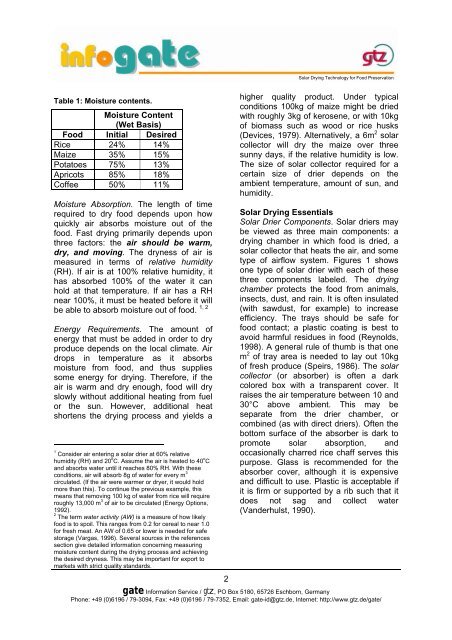Solar Drying Technology for Food Preservation - Pioneer Living ...
Solar Drying Technology for Food Preservation - Pioneer Living ...
Solar Drying Technology for Food Preservation - Pioneer Living ...
Create successful ePaper yourself
Turn your PDF publications into a flip-book with our unique Google optimized e-Paper software.
Table 1: Moisture contents.<br />
Moisture Content<br />
(Wet Basis)<br />
<strong>Food</strong> Initial Desired<br />
Rice 24% 14%<br />
Maize 35% 15%<br />
Potatoes 75% 13%<br />
Apricots 85% 18%<br />
Coffee 50% 11%<br />
Moisture Absorption. The length of time<br />
required to dry food depends upon how<br />
quickly air absorbs moisture out of the<br />
food. Fast drying primarily depends upon<br />
three factors: the air should be warm,<br />
dry, and moving. The dryness of air is<br />
measured in terms of relative humidity<br />
(RH). If air is at 100% relative humidity, it<br />
has absorbed 100% of the water it can<br />
hold at that temperature. If air has a RH<br />
near 100%, it must be heated be<strong>for</strong>e it will<br />
1, 2<br />
be able to absorb moisture out of food.<br />
Energy Requirements. The amount of<br />
energy that must be added in order to dry<br />
produce depends on the local climate. Air<br />
drops in temperature as it absorbs<br />
moisture from food, and thus supplies<br />
some energy <strong>for</strong> drying. There<strong>for</strong>e, if the<br />
air is warm and dry enough, food will dry<br />
slowly without additional heating from fuel<br />
or the sun. However, additional heat<br />
shortens the drying process and yields a<br />
1 Consider air entering a solar drier at 60% relative<br />
humidity (RH) and 20 o C. Assume the air is heated to 40 o C<br />
and absorbs water until it reaches 80% RH. With these<br />
conditions, air will absorb 8g of water <strong>for</strong> every m 3<br />
circulated. (If the air were warmer or dryer, it would hold<br />
more than this). To continue the previous example, this<br />
means that removing 100 kg of water from rice will require<br />
roughly 13,000 m 3 of air to be circulated (Energy Options,<br />
1992).<br />
2 The term water activity (AW) is a measure of how likely<br />
food is to spoil. This ranges from 0.2 <strong>for</strong> cereal to near 1.0<br />
<strong>for</strong> fresh meat. An AW of 0.65 or lower is needed <strong>for</strong> safe<br />
storage (Vargas, 1996). Several sources in the references<br />
section give detailed in<strong>for</strong>mation concerning measuring<br />
moisture content during the drying process and achieving<br />
the desired dryness. This may be important <strong>for</strong> export to<br />
markets with strict quality standards.<br />
2<br />
<strong>Solar</strong> <strong>Drying</strong> <strong>Technology</strong> <strong>for</strong> <strong>Food</strong> <strong>Preservation</strong><br />
higher quality product. Under typical<br />
conditions 100kg of maize might be dried<br />
with roughly 3kg of kerosene, or with 10kg<br />
of biomass such as wood or rice husks<br />
(Devices, 1979). Alternatively, a 6m 2 solar<br />
collector will dry the maize over three<br />
sunny days, if the relative humidity is low.<br />
The size of solar collector required <strong>for</strong> a<br />
certain size of drier depends on the<br />
ambient temperature, amount of sun, and<br />
humidity.<br />
<strong>Solar</strong> <strong>Drying</strong> Essentials<br />
<strong>Solar</strong> Drier Components. <strong>Solar</strong> driers may<br />
be viewed as three main components: a<br />
drying chamber in which food is dried, a<br />
solar collector that heats the air, and some<br />
type of airflow system. Figures 1 shows<br />
one type of solar drier with each of these<br />
three components labeled. The drying<br />
chamber protects the food from animals,<br />
insects, dust, and rain. It is often insulated<br />
(with sawdust, <strong>for</strong> example) to increase<br />
efficiency. The trays should be safe <strong>for</strong><br />
food contact; a plastic coating is best to<br />
avoid harmful residues in food (Reynolds,<br />
1998). A general rule of thumb is that one<br />
m 2 of tray area is needed to lay out 10kg<br />
of fresh produce (Speirs, 1986). The solar<br />
collector (or absorber) is often a dark<br />
colored box with a transparent cover. It<br />
raises the air temperature between 10 and<br />
30°C above ambient. This may be<br />
separate from the drier chamber, or<br />
combined (as with direct driers). Often the<br />
bottom surface of the absorber is dark to<br />
promote solar absorption, and<br />
occasionally charred rice chaff serves this<br />
purpose. Glass is recommended <strong>for</strong> the<br />
absorber cover, although it is expensive<br />
and difficult to use. Plastic is acceptable if<br />
it is firm or supported by a rib such that it<br />
does not sag and collect water<br />
(Vanderhulst, 1990).<br />
gate In<strong>for</strong>mation Service / gtz, PO Box 5180, 65726 Eschborn, Germany<br />
Phone: +49 (0)6196 / 79-3094, Fax: +49 (0)6196 / 79-7352, Email: gate-id@gtz.de, Internet: http://www.gtz.de/gate/


